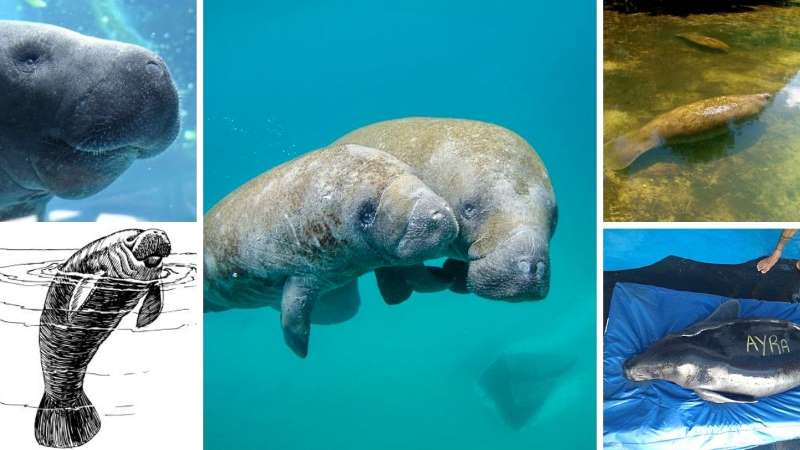
Species, characteristics, reproduction, baby manatee, habitat, danger of extinction + DRAWINGS + VIDEOS
There are three species of manatees in the world: one in Africa, Trichechus senegalensis, distributed along the coast and rivers of West Africa, and two in the Americas: the Caribbean manatee, T. manatus, which is found from the southeastern coast of the United States, especially in the Florida peninsula, to Brazil and the Caribbean; and the Amazonian manatee, endemic to the Amazon River basin, T. inunguis. Of these, the Amazonian is the smallest of the sirenians and the only one exclusive to freshwater.
✅ The manatee in history
The first European to record the existence of the Amazonian manatee was Christopher Columbus during his first voyage when the caravel La Niña approached the mouth of the Oro River. Later many other Europeans left their records, especially the chroniclers. Father Joseph de Acota, in 1590, in his Natural and Moral History of the Indies, wrote:
…there is what they call the manatee, a strange kind of fish, if fish can be called an animal that gives birth to its young alive, and has teats and milk with which it raises them, and grazes grass in the field, but in fact it usually lives in the water, and that is why they eat it for fish.
Joseph de Acota – Natural and Moral History of the Indies (1590)
Another chronicler, Father F.S. Gilij, who worked in the missions on the banks of the Orinoco River and was an expert linguist, pointed out almost two hundred years later, in 1780, in his Saggio di storia americana (Gilij 1965):
The meat of the manatee is so similar in taste to pork that it could surely fool even the most keen-smelling Spaniards. While still fresh, the manatee is very tasty, and good for making all kinds of delicacies.
F.S. Gilij – Saggio di storia americana (1780)
Indiscriminate hunting of the manatee
At that time it was not clear whether the manatee was a fish or a mammal. As a fish, it was consumed during Lent, without breaking the obligatory abstinence from meat consumption during Good Friday.

That misconception, its indefiniteness as a mammal, and its widespread consumption during Holy Week, stimulated the hunting and consumption of the manatee by urban consumers in the Amazon (Guevara-Porras, Morales-Vela, Olivera-Gómez 2019).
Another element that drove the indiscriminate hunting of the manatee was the tastiness of its meat, considered superior even to that of pork. This assessment prompted a strong pursuit of the animal.
And from 1542 onwards, a frenzied commercial hunting of the manatee began in the Amazonian rivers and lakes in Brazil, intensifying on a large scale until a little past the middle of the 20th century, when its hunting was banned.
✅ Location of the Amazonian manatee
The Amazonian manatee is found only in the water bodies of the Amazon basin, distributed in Bolivia, Brazil, Colombia, Ecuador, Peru and Venezuela. This endemic characteristic is due to its inability to reduce its peripheral heat loss, thus limiting its distribution to tropical waters.
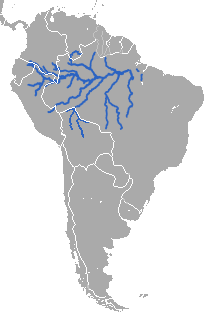
✅ Differences with similar species
Some confuse it with the Caribbean manatee, T. manatus, and others with the freshwater dolphin (Inia geoffrensis, Sotalia fluviatilis). With the former it differs especially in its size, and with the latter in that the latter is smaller, has an elongated snout, a dorsal fin, and lacks bristles (Tirira 2017, O’Shea 2014).
✅ Vernacular names
Almost everywhere it is called manatee. According to Corominas and Pascual, the term comes from the Carib language. Others say it comes from the Arawak.
The name of the genus Trichechus, comes from trix and echko, i.e. with hair. And the species inunguis means without nails. The Caribbean manatee does have nails on its flippers.
In Nahuatl they call him tlacamichin, or fish man.
And in Mayan, chiil’bek, which means big fish of the sea, clearly referring to the species of manatee that lives in the sea.
They call it “Manatín” in Mexico, which, as I said, refers more to T. manatus.
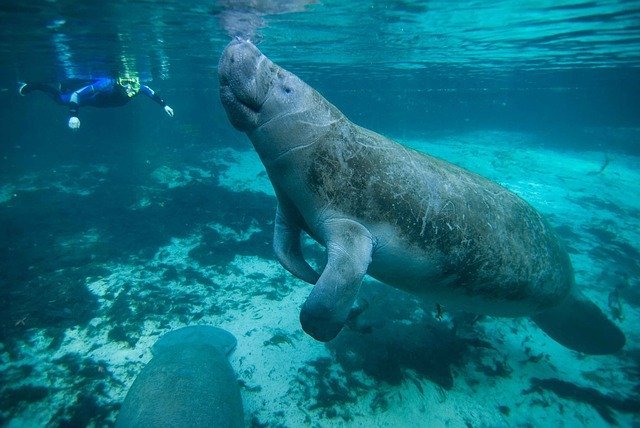
In some parts they call it a sea cow.
Peixe-boi is its common name in Brazil, that is, ox-fish.
Food: what do they eat?
The manatee is an aquatic, generally solitary, strict herbivore that feeds on emergent and floating plant species, such as lilies, hyacinths and water lettuce.
And it is a voracious species, consuming at least 8% of its body weight every day — that is, between 30 and 45 kg of vegetables in wet weight. In times of food abundance, the manatee eats more to build up fat reserves to anticipate times of scarcity.
✅ River manatee habitat
The manatee inhabits bodies of black and blue water (rivers and lagoons), located below 300 meters above sea level.
The blackwater rivers originate in the rainforest and are tributaries of the large whitewater rivers that originate in the Andes Mountains.
The Amazonian manatee also lives in flooded forests with a lot of vegetation, where it hides. In these bodies of water it moves slowly, moving its tail with ventral dorsal movements, advancing up to 3 km per day.
✅ Characteristics of the manatee
Early descriptions of the manatee show it as a combination of a seal and a hippopotamus.
He looks more like a quiet old man, with a friendly face, small eyes and very visible whiskers, and fins that look like oars to propel himself underwater.
In any case, the manatee arouses sympathy among people, due to its large size, its gentleness, and its herbivorous habits.

An adult specimen measures on average between 2 and 3 m, and weighs about 450 kg.
Its skin is smooth, soft and bare.
Its body color varies from dark gray to blackish.
It has a large white to pinkish spot on the belly.
In the mouth, the upper lip is extended, forming an oval disk, with large mobile lips, provided with stiff bristles, which serve for grasping.
Around its snout it has hairs, called vibrissae, which it uses to orient itself and “manipulate” its food.
Their forelimbs are shaped like short, rounded fins without nails. Hence its Latin name inunguis: without nails.
It lacks hind limbs.
The head is small and rounded.
The neck is short and thick, not well differentiated.
The eyes are small.
The ears lack pinnae.
They change teeth several times during their lifetime.
Males have their testicles in the abdomen, and females have their breasts, like teats, in the axillary area.
✅ Behavior
It is a tame animal, with both diurnal and nocturnal activity. Half of the time is spent swimming, and the other half is spent feeding (33%) and resting (17%).
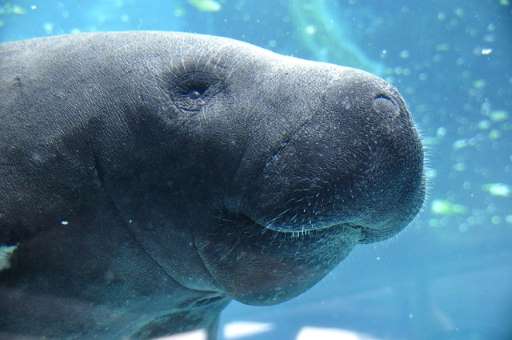
It lives a long time submerged in the water, but for periods of less than 14 minutes.
It then surfaces every 4 to 5 minutes, pulling its nostrils out of the water to breathe, and immediately submerges again.
In that brief instant, the manatee can replace the air in its lungs by 90 percent.
Communication
The species communicates with other individuals by aquatic signals of short frequency, about 3 KHz, which can be perceptible to the human ear.
The manatee has highly developed senses of hearing and touch. With its facial disc it explores the environment, and also uses it to scrape or rub the body of other individuals of its species.
With the little hairs located on its snout, it can perceive the movement of water and orient itself (O’Shea 2014).
✅ Estimated average life
There are different estimates on the longevity of the manatee in its natural habitat.
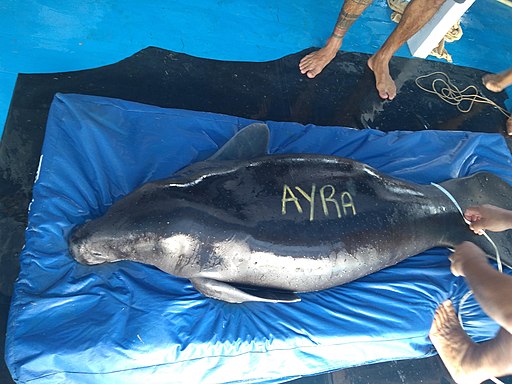
Source: Matheus Lopes/ICMBioCMA / CC BY-SA
Depending on where you look for information, the maximum life span is 50 years, or 60 years, or 70 years, or even 80 years.
In summary, it can be said that the Amazonian manatee reaches an age of more than 50 years in the wild.
However, the manatee is a shy, friendly, aquatic mammal, and is rated as one of the most harmless mammals in the world.
This fact plays against their survival. Their populations have been decimated by various factors, including poachers, and it is difficult to find a specimen in the wild that is more than 25 years old.
✅ The manatee in times of trough and crescendo.
The manatee lives in bodies of water that change with variations in the flow of rivers or lakes.
In times of flood, when rivers and floodplains form an interconnected body of water, manatees remain within the floodplain lakes, where the water current is weak and aquatic macrophytic plants are abundant, constituting their main forage.
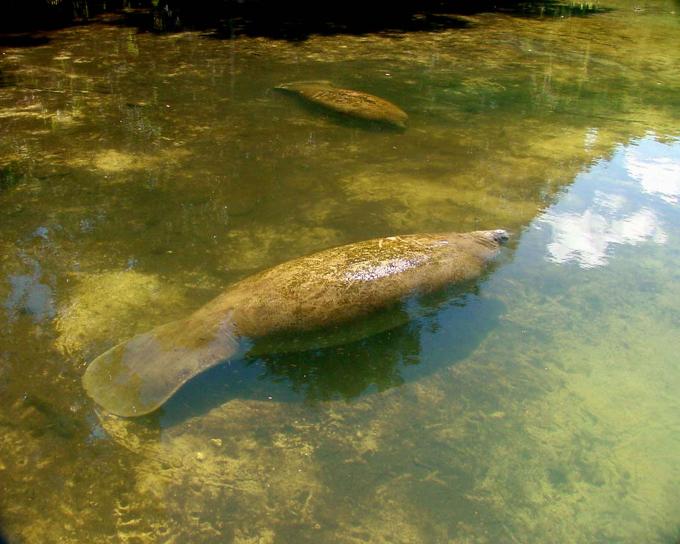
In the season when the rivers empty and the waters drop and most of the lakes are reduced, it is the time for migration.
As the dry season approaches, the manatee leaves its usual living areas during the season of abundant water, and migrates to other more favorable habitats, seeking refuge.
Water levels drop rapidly, and “bottlenecks” form along the sometimes long migration route.
The manatee migrates in search of food (grass) just before the drought, without compromising its safety.
If they stay and do not migrate, they will become very vulnerable to their predators, the indigenous and commercial hunters, the jaguar that stalks them, the nets of commercial fishermen, and the passing speedboats that run over them (what is called “incidental mortality”).
Moraes-Arraut and his research group (2017) put forward the thesis that the manatee possesses an updatable cognitive map of its environment, and that it is behaviorally plastic, i.e. flexible.
With this ultra-perceptive faculty, the manatee can monitor the depth of the river to begin the migration as the body of water begins to empty, while the macrophyte plants, on which it feeds, die.
They look for areas that never dry out, no matter the season, such as, for example, Lake Amaná, in the western Brazilian Amazon, located in the Amaná Sustainable Development Reserve.
Population
In general, relatively little is known about the manatee, and it has not been possible to estimate the existing population in most rivers of the Amazon basin (Silva, Montes, Elías 2014).

Matheus Lopes/ICMBioCMA / CC BY-SA
A study conducted in 2019 in the rivers of the Cuyabeno Reserve and Yasuní National Park, located in the Ecuadorian Amazon, using side-scan sonar operating at frequencies ranging from 200 to 450 kHz, above the hearing range of manatees, found a population density of between 0.9 and 1.09 individuals per km2.
By extrapolating the data obtained, the study made it possible to estimate a population of about 150 manatees in that part of the Amazon (Paz-Cardona 2020).
✅ Reproduction of the manatee.
The manatee is a solitary mammal, except during the mating and breeding season, or when they coincide, sometimes, in feeding places.
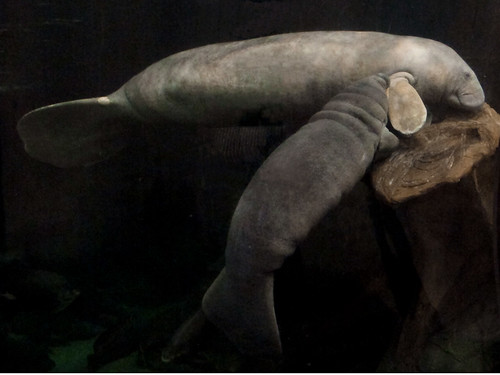
The reproductive cycle is associated with the hydrological cycle of their habitat and the availability of their food.
The female manatee gives birth to a single calf each time, after a long gestation period of 12 to 14 months, which generally occurs between the months of December to July, with a higher concentration of frequency from February to May, when the waters rise and there is greater availability of plant food in the bodies of water.
Baby manatee (+VIDEOS)
The calf stays with the mother for about two years, when it separates to begin its independent life. The period between calving is not less than five years, including the pregnancy and lactation phases.
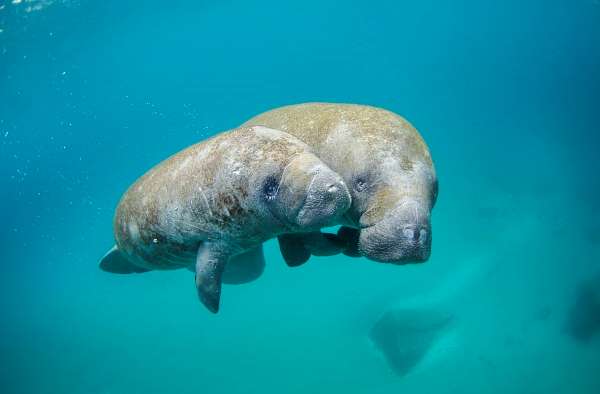
The calf is born weighing between 10 and 15 kg, and measuring between 85 and 105 cm in length. It increases in size at a rate of 2 mm per day, and gains an average of 1 kg of weight per week.
Female offspring reach sexual maturity at four years of age, while males reach sexual maturity at six years of age.
Manatee in danger of extinction
The particular conditions of its reproduction (a single calf, a gestation period of 12 to 14 months) have made the manatee a vulnerable and endangered species. In addition to its meat (reputed to be “the tastiest in the world”), its abundant fat and skin are highly sought after by hunters.
Feitorias (the hunts)
They say that only the most skillful and ingenious fishermen can catch a manatee.
The indigenous people pass on their knowledge of manatee behavior from generation to generation and know well the “arribacao” times when the manatees leave their shelters to migrate to Lake Amaná and Lake Castanho.
During that time of migration, about 120 km are covered with great dangers along the route. Exposed and vulnerable, manatees suffer great losses in their hapless migrations.
Thus, during migration, large manatee hunts, known as “feitorias,” take place, and the manatee becomes a very vulnerable species (Calvimontes et al, 2010, Calvimontes 2009).
Manatee mythology
Manatee or mermaid?
For centuries, the manatee was believed to be a fish, related to mermaids. The manatee is, in reality, a sirenian, and the rest is the result of the imagination of the people, who see the female manatee as the reincarnation of a woman.
Perhaps this story is related to the fact that the female’s mammary glands are located at armpit level, and when nursing in an upright position, holding her calf between her pectoral fins, she looks like a woman nursing her young. In addition, manatees have a caudal fin, as the mermaids are said to have had.

The Spanish and Portuguese discoverers and their chroniclers mentioned mermaids as well. They saw the manatees emerging to the surface of the water carrying seaweed or sargassum or other plants on their heads, like a scalp, resembling a mermaid.
Columbus noted in his diary that he saw three mermaids. We have already mentioned the chronicler Acosta telling how he was amazed by the female manatee “with teats and milk” to raise her children.
The indigenous people consider the manatee to be a mixture of fish and ox (hence its Brazilian name peixe-boi).
They were amazed by the stealthy way the manatee acted, attributing it to its highly developed hearing and sensory ability.
The indigenous people say that it is a very intelligent fish, that it knows and learns, and that it has an understanding similar to that of a person, giving it an “almost magical” condition.
Drawings of manatees
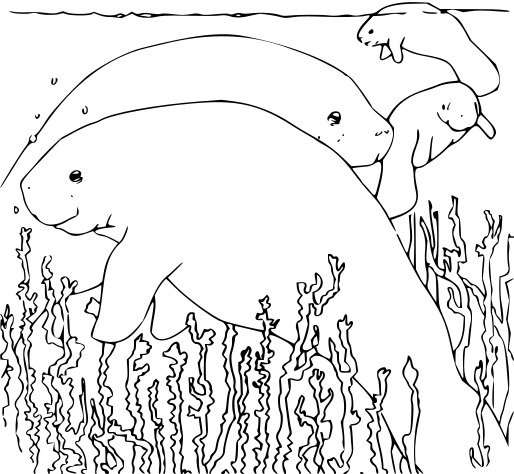
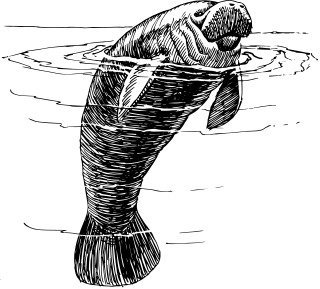

Bibliography
- Acosta J.A. 1940 (1590). Historia natural y moral de las Indias. Mexico: FCE. PDF
- Calvimontes J. 2009. Ethno-knowledge, use and conservation of the Amazonian manatee Trichechus inunguis , in the Amaná sustainable development reserve, Brazil. Thesis of Specialty in Forest Resources Conservation. Lime. La Molina Agrarian University. PDF
- Calvimontes J, Marmontel M., Fuentes A.M., …Pulido-Silva M.T. 2010. Ethnobiological studies on the Amazonian manatee(Trichechus ininguis Natt 1889) and its conservation in the Amaná Sustainable Development Reserve, Brazil, 397-402, Source.
- Ladrón de Guevara-Porras P., Morales-Vela B, Olivera-López L.D. 2019. The manatee, a species under threat of extinction. Marine mammals of Mexico. Science. Vol. 70 (3), 38-47, July-September. PDF
- Moraes-Arraut E., Arraut J.L., Marmontel M., Mantovani J.E., Leao de Moraes Novo M. 2017. Bottlenecks in the migration routes of amazonian manatees and the threat of hydroelectric dams. Acta Amazonica, 47 (1), 7-18, Jan.-Mar. PDF
- O’Shea T.J. 2014. Family Trichechidae (Manatees), 548-563. In: Wilson D.E., Mittermeier R.A. (eds.). Handbook of mammals of the World. Vool. 4. Sea Mammals. Barcelona: Lynx Ediciones. PDF
- Paz-Cardona A.J. 21.02.2020. For the first time there is an estimate of how many Amazonian manatees there are in Ecuador. MONGABAY. en. mongabay.com/ 2020/01/ conservation-of-amazonian-manatees-in-ecuador./ PDF
- Silva J., Montes D., Elías R. 2014. Knowledge, conservation and sighting of the Amazonian manatee(Trichechus inunguis), according to the inhabitants of the Ucayali river basin (Loreto, Peru). Health Tech. Vet. 2014 (2), 32-38. PDF
- Tirira D.G. 2017. Field guide to the mammals of Ecuador. Quito: Asociación Ecuatoriana de Mastozoología and Editorial Murciélago Blanco. 2nd. ed. PDF
- Vallejo A.F., Boada C. 2018. Trichechus inunguis. In: Brito j., Camacho M.A., Romero V., Vallejo A.F. (eds.). Mammals of Ecuador. Version 2018.0. Quito. Zoology Museum. Pontificia Universidad Católica del Ecuador (PUCE). Source
- Weber-Rosas F.C. 1994. Biology, conservation and status of the Amazonian Manatee. Trichechus inunguis. Mammal Review. Vol. 24 (2)49-59, June. Source
This post is also available in:
![]() Español (Spanish)
Español (Spanish)



